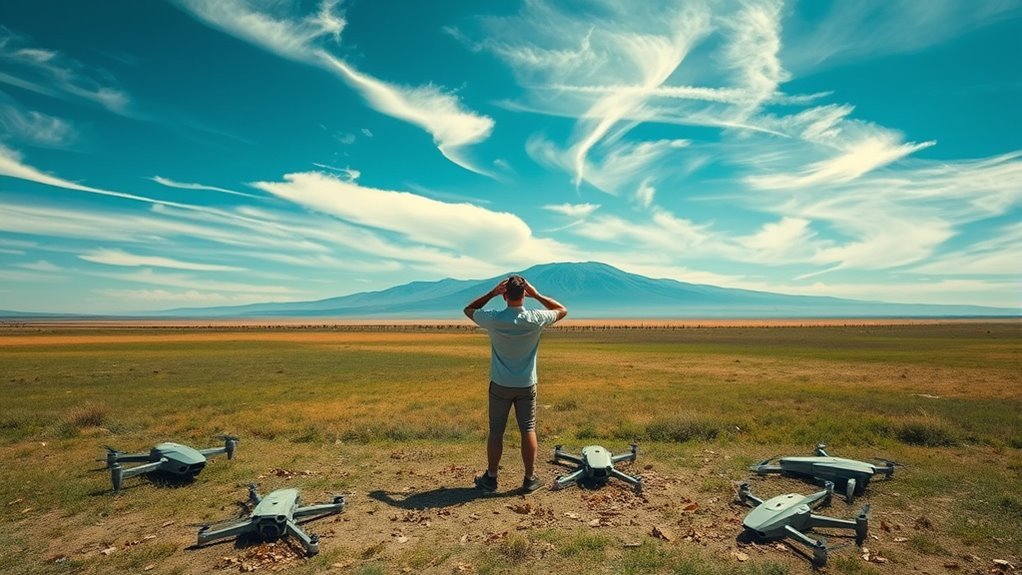Drones have markedly evolved since their military inception in World War I. They’ve shifted into essential tools across various sectors, including agriculture, disaster response, and infrastructure inspection. While their capabilities are impressive, regulatory challenges and safety concerns often hinder their widespread acceptance. Despite technological limitations, ongoing innovations are reshaping the future of drones. If you’re curious about their journey, current impact, and potential, there’s a lot more to explore on this fascinating topic.
The Rise of Drones: A Brief History

As technology evolved, so did the concept of flight, leading to the rise of drones, which have reshaped various industries. The drone origins can be traced back to military applications during World War I, where early innovations focused on unmanned surveillance and target practice. These pioneering efforts laid the groundwork for today’s sophisticated drones. In the decades that followed, advancements in electronics and robotics fueled further development, converting drones from military tools to commercial and recreational devices. As you explore this fascinating history, you’ll discover how these aerial vehicles have transformed the way we perceive freedom in the skies, revealing possibilities that empower individuals and organizations alike. Embracing this evolution, you can appreciate the journey from rudimentary devices to the dynamic drones we recognize today. The integration of AI-powered obstacle detection and other advanced technologies has revolutionized drone safety and operational efficiency, further enhancing their capabilities. Today, drones like the Draganfly Commander exemplify the cutting-edge design and functionality that have emerged from this historical evolution.
Current Applications and Use Cases

The evolution of drones has opened up a myriad of applications across diverse fields, greatly impacting industries and everyday life. For instance, in agricultural monitoring, drones enable farmers to assess crop health efficiently. During disaster response, they provide critical aerial views for rescue efforts. Infrastructure inspection has become easier, allowing for safer evaluations of bridges and buildings. Environmental conservation benefits from wildlife tracking, helping researchers gather data without disturbing ecosystems. Recreational use, like aerial photography, offers enthusiasts breathtaking perspectives. Furthermore, the rise of package delivery services demonstrates drones’ potential to revolutionize logistics. Each application underscores drones’ versatility and their ability to enhance efficiency, safety, and creativity in various sectors, ultimately contributing to a more liberated, connected world. Additionally, drones are transforming public health by enhancing medical supply delivery, ensuring timely access to essential medications and diagnostics. Notably, autonomous spraying technologies are being integrated into agricultural practices to optimize fieldwork efficiency and reduce environmental impact.
Regulatory Challenges and Restrictions

As you explore the world of drones, you’ll quickly notice that government regulations play a significant role in their operation. Understanding airspace restrictions and privacy concerns is vital, as these factors can greatly affect how and where drones are used. Maneuvering through these regulatory challenges is essential for anyone looking to harness the full potential of drone technology. Additionally, recognizing federal guidelines regarding drone use is crucial for compliance and avoiding legal issues.
Government Regulations Impact
While many enthusiasts envision a future dominated by drones, maneuvering through the complex landscape of government regulations presents significant challenges that can stifle innovation. You might find that rules designed to guarantee safety and manage air traffic often prioritize government surveillance over individual freedom. These regulations can restrict where and how you operate your drone, limiting your ability to explore its full potential. Furthermore, the fear of regulatory penalties can deter hobbyists and businesses alike from engaging with drone technology. This creates a paradox where the very tools designed to enhance our lives are shackled by restrictions. As you navigate this terrain, it’s essential to advocate for regulatory frameworks that support innovation while balancing safety and privacy concerns.
Airspace Restrictions Overview
Maneuvering airspace restrictions can feel overwhelming, especially when you’re keen to release your drone’s capabilities. Understanding airspace management is vital for successful drone integration. Various regulations, such as no-fly zones and altitude limits, can restrict your flight options. You’ll often find that commercial and public airspaces are tightly controlled, making it important to stay informed about local laws. Additionally, as drone technology evolves, regulatory bodies continuously update guidelines to guarantee safety and efficiency in the skies. By keeping abreast of these changes and using apps or databases that track airspace restrictions, you can navigate the skies more freely. Embracing this knowledge empowers you to maximize your drone’s potential while adhering to necessary regulations.
Privacy Concerns Addressed
Though drones offer exciting possibilities for aerial photography and surveillance, they also raise significant privacy concerns that regulators must address. The balance between embracing innovation and ensuring data privacy is delicate. Drones can capture vast amounts of personal information, potentially infringing on personal space without user consent. This creates dilemmas surrounding surveillance ethics and the digital footprint left behind. As law enforcement increasingly employs drones, public trust hinges on transparent information security measures that protect individuals’ rights. To foster a responsible drone culture, regulatory frameworks must prioritize user consent and establish clear boundaries. By addressing these challenges, we can harness the benefits of drones while safeguarding our privacy and ensuring ethical use in our communities.
Safety Concerns and Public Perception
As concerns about safety continue to rise, public perception of drones remains a complex issue shaped by a mix of fear, fascination, and misunderstanding. You might find that many people associate drones with potential dangers, from mid-air collisions to privacy violations. This apprehension often stems from a lack of safety education, which can erode public trust in drone technology. Engaging communities through informative campaigns can help demystify drones, showcasing their benefits while addressing safety concerns. When individuals see how drones enhance emergency response and environmental monitoring, their perspectives shift. Furthermore, advanced risk management techniques can ensure that drone operations are conducted securely and responsibly. Additionally, ensuring compliance with drone registration requirements is crucial for promoting a safe flying environment. By fostering open dialogue and prioritizing safety education, we can build a rapport that transforms fear into acceptance, paving the way for a future where drones are embraced rather than feared.
Technological Limitations and Innovations
While advancements in drone technology have been impressive, significant limitations still hinder their widespread adoption and effectiveness. You’ll notice that sensor technology isn’t always accurate enough for precise data transmission, impacting autonomous navigation. AI-enhanced obstacle avoidance features are being developed to improve safety and reliability, but challenges remain in complex environments. Battery efficiency remains a challenge, as many drones can’t sustain long flights, limiting their payload capacity. AI integration is slowly evolving, but collision avoidance systems still struggle in complex environments. Flight stability can be compromised in adverse weather conditions, testing material durability and weather resilience. As you explore the landscape of drone technology, it’s clear that innovations like enhanced sensors and improved battery life are essential for overcoming these barriers, paving the way for a future where drones can truly realize their potential. Furthermore, advancements in multispectral cameras are driving operational efficiency across industries, showcasing the transformative role of drones in data collection.
The Future of Drone Technology
As you look ahead, the future of drone technology holds exciting advancements in design that could enhance performance and efficiency. However, regulatory challenges loom, potentially shaping how these innovations are implemented across various industries. With emerging applications ranging from delivery services to agricultural monitoring, the next few years promise to redefine what drones can achieve. Innovations in AI-driven autonomous navigation will play a crucial role in ensuring safer flights and enhancing user experiences. Additionally, advancements in proactive vulnerability identification will help ensure that drone systems remain secure against evolving threats, fostering trust in their operations.
Advancements in Drone Design
With the rapid evolution of technology, advancements in drone design are reshaping the possibilities for various industries. You’ll notice how drone aesthetics have transformed, moving beyond mere functionality to embrace sleek, innovative forms that enhance user experience. These design evolutions not only improve aerodynamics but also increase efficiency and payload capacity. As manufacturers incorporate lightweight materials and smart technologies, drones become more versatile, adapting to tasks like agriculture, delivery, and surveillance. This shift allows you to explore previously unattainable opportunities, granting freedom to creators and businesses alike. The future of drone technology hinges on these advancements, promising a blend of art and science that reflects your desire for exploration and innovation in a rapidly changing world.
Regulatory Challenges Ahead
Despite the excitement surrounding advancements in drone technology, significant regulatory challenges loom on the horizon. As you navigate this evolving landscape, it’s essential to understand how public policy and industry standards will shape the future of drones. Regulations are vital for safety, but they can also stifle innovation if overly restrictive.
| Regulatory Aspect | Current Status | Future Implications |
|---|---|---|
| Public Policy | Fragmented | Potential for unification |
| Industry Standards | Developing | Need for collaboration |
| Compliance | Complex | May hinder small businesses |
Balancing freedom and safety will require active participation from stakeholders. As regulations evolve, your voice matters in advocating for sensible policies that promote innovation without compromising safety.
Emerging Industry Applications
While many people associate drones primarily with recreational use, their potential applications in various industries are rapidly expanding. You’ve likely noticed their role in agricultural monitoring, where they provide real-time data to optimize crop yields. In disaster response, drones can swiftly assess damage, ensuring aid reaches those in need. Aerial photography captures stunning visuals for urban planning, while package delivery systems are revolutionizing logistics. Drones also play an essential part in wildlife conservation, tracking endangered species without disturbing their habitats. Moreover, in infrastructure inspection and industrial maintenance, they reduce risks and improve efficiency. As you consider these emerging applications, it’s clear that drones are not just flying gadgets—they’re indispensable tools shaping the future of numerous industries.
Frequently Asked Questions
What Are the Environmental Impacts of Drones?
Did you know that drone pollution can release up to 30% more greenhouse gases compared to traditional delivery methods? Additionally, their operation can lead to habitat disruption, impacting wildlife and ecosystems markedly.
How Do Drones Affect Wildlife and Ecosystems?
Drones can considerably affect wildlife by causing disturbances during ecological monitoring. Their noise and presence may alter animal behavior, leading to stress and habitat abandonment. Understanding these impacts is essential for balancing technology use and wildlife protection.
Can Drones Be Used for Personal Delivery Services?
Absolutely, drones can revolutionize personal delivery services. However, they’re subject to drone regulations that guarantee safety. With advancements in technology, you’ll likely see more convenient, efficient delivery options at your doorstep soon.
What Are the Ethical Implications of Drone Surveillance?
So, you think watching your neighbor’s barbecue is harmless? Drone surveillance raises serious privacy concerns, blurring lines between personal freedom and military applications. It’s a slippery slope—who’s watching the watchers, anyway?
How Do Weather Conditions Affect Drone Operations?
Weather conditions greatly impact drone operations. Wind interference can destabilize flights, while rain limitations reduce visibility and risk damage. Understanding these factors guarantees you optimize drone usage, enhancing both performance and safety during various weather scenarios.

